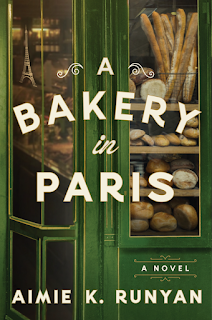Aimie K. Runyan is the author of the new historical novel A Bakery in Paris. Her other books include The School for German Brides. She lives in Colorado.
Q: What inspired you to write A Bakery in Paris, and how did you create your characters Lisette and Micheline?
A: I was idea hunting in mid-2020 (hey, we all needed a distraction) and I happened to be dating a historian at the time. Knowing my interest in French language and history, he suggested I look into writing something on the Paris Commune. I did some reading and thought it would be a fantastic setting for a story.
As far as the characters go, I loved the idea of a wealthy girl (Lisette) giving up her privilege for the sake of causes she believes in. Conversely, I really enjoyed creating a character who creates her own agency in a life where so many decisions are made for her based on circumstances (Micheline). They really came to me as I read up on both time periods.
Q: The novel takes place over two timelines, in 1870 and 1946. Can you say more about how you decided on those time periods, and how you researched France in those years?
A: I decided to pair the Paris Commune with postwar Paris to show the city rising up after two separate conflicts. To show how many times this beloved city and her people have risen up out of the ashes.
Well, given that most of this book was written while international travel was impossible, I relied a lot on traditional research books, purchased and from the library. Archival work and travel to the sites weren’t possible until the book was in copy edits. I did get to visit many of the places mentioned in the book at that phase and was able to add in some details.
Q: How would you compare your two protagonists, both of whom face daunting difficulties?
A: Lisette has a LOT more choices upfront than Micheline, though she deliberately gives up many of those choices when she leaves home. In giving up her family money and standing, she sets the rest of her family on a course for a more modest lifestyle, for better or worse.
Micheline is strong and despite being put in the very difficult position of raising her sisters and grieving for her parents, she manages to do it on her own terms, as much as any of us can. She is given an opportunity to run a bakery, but in the end, she really has to choose it.
Q: Did you know how the novel would end before you started writing it, or did you make many changes along the way?
A: I knew more or less how it would end before I set pen to paper, and while the murky middle always surprises me, I think the end was very much how I envisioned.
The biggest change I made was dropping a 1990s timeline that I’d strongly considered. I kept writing poor Veronica’s first chapter, and she never took off. In the end, I think scrapping the timeline was for the best. I used some of that character’s arc and angst for a different project and was able to use the space I would have devoted to that character to really fill out Micheline’s timeline.
Q: What are you working on now?
A: My current project is called Mademoiselle Eiffel and it’s the story of Claire Eiffel, the daughter of Gustave Eiffel, the famed architect responsible for countless bridges, the Statue of Liberty’s interior structure, and the tower that bears his name in Paris.
At the age of 14, Claire took over running his household, assisting in his business, and helping to raise her four younger siblings when her mother died. Hers is a fascinating story and one I’ve enjoyed telling!
Q: Anything else we should know?
A: In February of 2024, I’ll be releasing my first work of contemporary Women’s Fiction with Harper Muse, entitled The Memory of Lavender and Sage. It’s the story of a woman traveling to her late mother’s village in Provence to learn more about her past and to find her place in a future that is wildly different from the one she imagined for herself.
--Interview with Deborah Kalb. Here's a previous Q&A with Aimie K. Runyan.


No comments:
Post a Comment